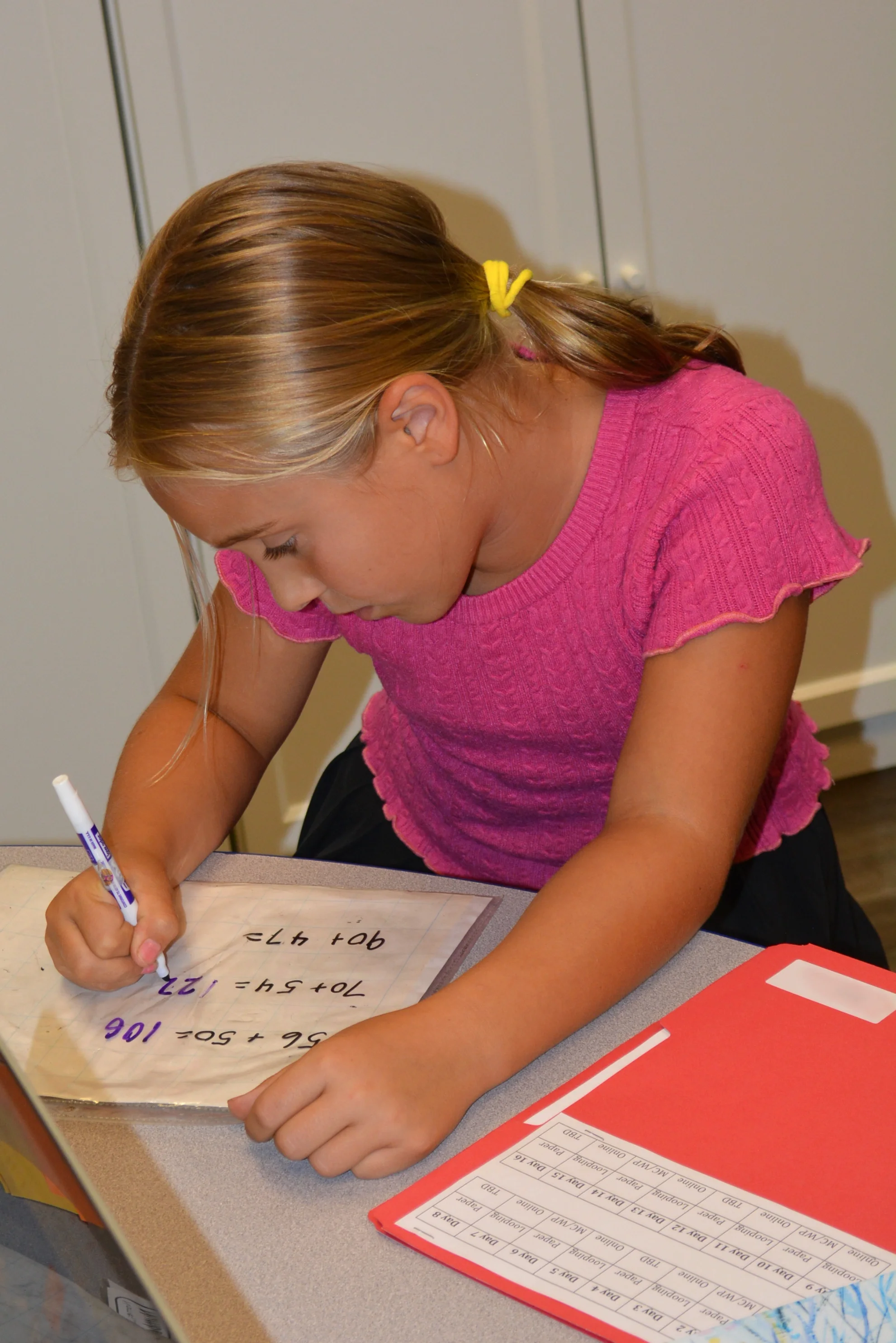What Individualized Math Looks Like
A teacher and student work together to learn a new math concept during looping time.
If you walked into a math class at Vine, you’d see the teacher and one or two students passing math problems back and forth, keeping busy almost every second. She would be using wipe-off sheets and erasable markers to constantly add, correct and erase problems. In a single moment, you might see the teacher setting up a word problem with percentages, while the student is solving a problem on perimeter. “These problems have nothing in common!” you might think to yourself. “Why are they doing it like that?”
In the midst of this, you may notice something even more important…each student is doing math, a LOT of it, and doesn’t seem to mind it one bit! In fact, it even appears that they’re having a bit of fun. This is one of our favorite strategies: Math Looping℠.
While looping, the teacher is simultaneously working on a multitude of math skills, one right after another. While doing this, she is adjusting the level of the next problem or question within each skill to adapt to each student’s level of readiness. For instance, if a student gets a simple equation correct in the first “loop,” their teacher will give them a slightly harder equation in the next “loop.” If a student incorrectly solves that equation, the teacher will offer a slightly easier version in the next “loop.”
Math Looping is a tutoring technique rooted firmly in educational principles that are shown to work:
Students should be actively engaged with learning at every possible moment.
When students are learning, they should be doing… not just listening. The pencil should be in their hands
Students learn best in the “zone of proximal development.” This is the place where learning is challenging enough to be interesting, but never so challenging that it’s overwhelming. With looping, our teachers reflect on each question that their student answers, adjusting the difficulty level of the next activity to stay right in this zone.
Students need to be exposed to skills over and over again. Instead of teaching concepts in-depth from the beginning, we present each skill over a longer period of time, increasing the depth as the student is ready. This helps move information into long-term storage so students learn concepts to mastery level.
What are the Other Students Doing?
Math classes have just six students and one teacher. The teacher works directly with students two at a time. That means that each student gets direct teacher instruction one-third of the time. The rest of the time, students are practicing with the teacher nearby. Students practice on paper for about half of their practice, via activities carefully selected by the teacher. The other half of their practice time is spent on a computerized program that reinforces their learning. We use few programs at Vine, but we have found that Aleks (for grades 3-8), and Dreambox (for grades K-2) do an excellent job helping bring students to true mastery when used as part of our curriculum. Our teachers teacher our students directly, our students engaged in individualized practice, and these programs help us reinforce what is learned. Our high schoolers don’t work much on computerized programs; almost all of their practice is on paper.
Extra Math in Elementary School
Our students in grades K-4 take two math classes each day. We do this so that we can lay a very solid foundation of math skills in the early years and so that we have plenty of time to teach our students to have fun with math. Each student has a regular math class each day, as described above. In our elementary program, much of our paper and pencil math practice comes from the Singapore Math series. In their second math class of the day, students are in slightly larger groups and get to play with their math. Using manipulatives, dice, playing cards, and shape tiles, students play games that have them apply math in a highly engaging format. They play games together, practice skip counting, solve word problems, and more….all while learning that math is fun!
What is the High School Math sequence?
High schoolers’ math classes are highly individualized. High schoolers can take math classes at a regular or honors level. High schoolers are initially placed in our sequence based on their junior high math master. The high school math sequence is as follows:
Algebra I or Honors Algebra I
Geometry or Honors Geometry.
Algebra II or Honors Algebra II
Trigonometry & Pre-Calculus or Honors Trigonometry & Pre-Calculus
Honors Calculus (this may be a two or three semester course)
Honors Statistics (a one semester course)
Math Looping is a service mark of Nurturing Wisdom, Inc. and was developed by
Amanda Vogel in her time as Vice President of Nurturing Wisdom Tutoring.

